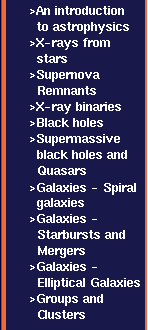


|
GALAXIES - MERGING GALAXIES What are merging galaxies?The past three decades have witnessed a revolution in our understanding of how galaxies evolve. Galaxies are no longer thought of as `island universes' evolving slowly in complete isolation. Rather, galaxies are now known to interact in a variety of ways with their environment, which consists of satellites, neighbouring galaxies, and sometimes vast masses of tenuous hot gas. Among these interactions, mergers of galaxies have become possibly the dominant evolutionary mechanism. When galaxies pass close to one another, the tidal forces between them can alter their structure. In mergers, the galaxies do not just pass close to one another, but actually collide and, over time, coalesce into a single object. The gravitational forces during the merger completely disrupt the galaxies, changing the orbits of the stars and breaking up structures like disks or spiral arms. Many galaxies show signs of having undergone mergers in the past. Indeed, if events during galaxy formation are counted, there are probably few galaxies that were not shaped by interactions or even outright mergers. The position of a galaxy in Hubble's famous galaxy morphological sequence may depend largely on the number and severity of merger events in its past history. Pure spiral disc systems, formed from relatively isolated protogalactic gas clouds, appear at one end of the Hubble sequence, the giant ellipticals, possibly produced through mergers of similar spirals, at the other. In between, mergers between galaxies of differing mass produce galaxies with a wide range of bulge to disc ratios. Interacting and merging late-type galaxies are, in general, ultraluminous in all wavebands. The rapidly changing gravitational forces allow the gas to lose angular momentum and fall to the galaxy centre, where it is compressed, giving rise to massive bursts of star formation involving up to 10% of the visible matter in the galaxy. Tidally-induced tails and bridges of stellar and interstellar material are common within and around interacting and merging galaxies, and their shapes and properties have been modelled by high-speed N-body computer simulations. How do merging galaxies appear in X-rays? Through the X-ray evolution of a merger a great deal of interesting structure can be seen. Bright starbursts are formed at the galaxy nuclei, and as the systems' nuclei collide, huge, diffuse gaseous structures are seen, appearing to arise from material ejected from the galaxies (as is also seen in starburst galaxies, but to a larger degree). As the encounter relaxes, a small X-ray halo is seen to encompass the single lone remnant of the collision. |
|
|
![[Mergers]](images/starburst/mergers.jpg)
![[Antennae]](images/starburst/ant1b.jpg)

